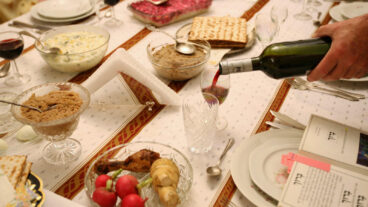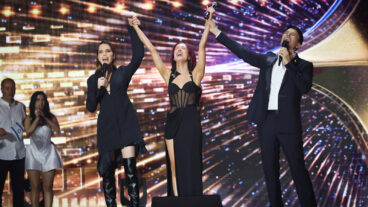A dance party on the beach in Tel Aviv – the ultimate east-meets-west city. (Photo: Ministry of Tourism)When it comes to the types of urban amenities needed to create a world-class destination, Tel Aviv has it all. Its real estate – a prime slice of Mediterranean ringed by silky beaches – evokes the sizzle of Rio coupled with the style of Miami. Tel Aviv’s locals sport the types of military-toned bodies and summer tans all year round that model agencies worldwide are made of. Its food is a blend of European traditions spiced with Levantine and Arab influences. And its carefree attitude and all-night club culture reflects an air of openness and tolerance that could serve as a model in other democratic countries.
Whether its thanks to a boom on the Tel Aviv stock exchange, or last year’s designation of the city’s Bauhaus core as a UNESCO World Heritage Site, or a surge in foreign real estate investment (now reaching $100 million per month), Tel Aviv finally appears ready for its international close-up.
For those taking the plunge across the Atlantic, what awaits on Tel Aviv’s Mediterranean shores is a destination of both surprisingly complexity and accessibility.
“Tel Aviv is the ultimate east-meets-west city,” observes Talya Halkin, a former New Yorker who now writes about culture for the English language daily The Jerusalem Post. “You have the best of European sophistication and Middle Eastern exoticism – sometimes just a block away.”
Such sophistication is now evident city-wide. There are slick new straight and gay bars and sleek health clubs, city-center bike paths and a burgeoning cycle culture to go with it. Dizengoff Street, the city’s ’70s-era retail HQ, has reemerged as a corridor of surprisingly sophisticated local design.
And the Bauhaus Center and Museum celebrates Tel Aviv’s architectural patrimony. Add in a new $1 billion airport designed by native son Moshe Safdie and a new high-speed train connecting it to the city center, and Tel Aviv emerges as a city clearly in a hurry – though for its tourists, there are ample reasons to slow down and enjoy the ride.
Neve Tzedek
One of the best spots for a stroll is Neve Tzedek, one of Tel Aviv’s first neighborhoods, filled with original Ottoman-era architecture, high-end independent fashion boutiques, designer day spas and the Suzanne Dellal Center, home of the world-renowned Batsheva Dance Company. Neve Tzedek is to Tel Aviv what SoHo is to Manhattan – a gentrified relic of an age long lost to urbanization and consumerism. What was once a south Tel Aviv slum now houses numerous multi-million dollar homes favored by artists and other creative types.
Like SoHo, there is nothing ‘undiscovered’ about Neve Tzedek – or Tel Aviv’s other main tourist districts such as its Arab sister city of Jaffa, the Dizengoff Street shopping corridor and, of course, its miles of beaches. Less known, perhaps, is Tel Aviv’s vibrant cultural scene, which considering the city’s size, rivals London or New York for sheer musical, theatrical and artistic variety.
A Taste of the Arts
While an earlier generation of Israeli creative types ranging from conductor Daniel Barenboim to industrial designer Ron Arad had to leave the country to find international fame, their successors are confidently thriving at home.
“Tel Aviv has grown into a serious cultural center that is professional, dynamic and very international,” explains 32 year-old international musical sensation Gil Shohat, the newly appointed artistic director of the Israel Chamber Orchestra, who returned to Tel Aviv after studies throughout Europe. “This year alone we are collaborating with over 90 musicians from around the world as well as mounting two tours abroad.”
Under choreographer Ohad Naharin, who trained at Julliard and danced with Martha Graham, Tel Aviv’s Batsheva Dance Company, for instance, has developed an Israeli twist to this classic medium both domestically – such as in a recent mega-production in the desert – and through 200 annual overseas performances.
Contemporary artists such as Nir Hod, Sigalit Landau and Adi Nes, meanwhile, are also helping give Israel the beginnings of a discernible, yet internationally approachable style.
The Sound of Music
Along with its thriving classical music and opera offerings, Tel Aviv can also claim one of the most innovative pop music scenes in the Europe/Middle Eastern region. From world music practitioners like Idan Raichal, to hip hop innovators like Hadag Nachash, to national “classic” rockers such as Shalom Hanoch and Yehudah Poliker, to “indie” masters like Ivry Lider or Hayehudim (The Jews), Tel Aviv pulses with an endless array of contemporary music acts and concerts.
Most artists, naturally, perform in Hebrew, but live performances are a great way to get into the groove, despite the language barrier. English language media such as Time Out Tel Aviv’s English-language edition along with weekend entertainment supplements in The Jerusalem Post and Ha’aretz give detailed listing of current music events. The Barbie Club hosts many of the up and coming Israeli artists, and for a more alternative scene, try the punky Jah-Pan club.
For music fans unsure where to begin, head for The Third Ear, a temple of local and global music and CDs close to Dizengoff Center on trendy Sheinkin Street. Just tell the friendly staff you’re looking for local sound with a global flavor and they?ll easily find an appropriate Israeli musical match. Who knows – your new favorite Israeli band may just be gearing up for a show or two while you’re in town.
Walking and biking
Unlike New York or London, however, thank to Tel Aviv’s compact size – a mere 33 square miles – all of the city’s best bets are within easy reach.
“Everything is readily accessible, which makes for people who are casual, informal and incredible friendly,” explains jeweler Sharon Alouf, a Tel Aviv native who makes quarterly trips home from her Manhattan base.
Adds Eytan Schwartz, the Upper East Side-born, Tel Aviv-bred winner of the recent hit Israeli reality series The Ambassador who now helps promote Israel in the US, “whether bar hopping, or restaurant hopping or club hopping, everything you need is always within walking distance.”
And walking, or better yet, biking – with wheels rented from O-Fun; 245 Dizengoff St.; 03-5442292; NIS40 ($9) per day – is really the best way to experience Tel Aviv’s urban intimacy. Stroll through the White City, its iconic, UNESCO-lauded Bauhaus core built by European immigrants fleeing from the Nazis during the first half of the 20th century.
Or spin along the Tayelet, (Promenade) Tel Aviv’s sea front promenade extending from Jaffa in the south to the newly renovated Tel Aviv Port in the north, filled with open-air restaurants, cafes, shops and spas. Or even stroll around posh Kikar Hamedina (State Square) in North Tel Aviv, where nestled among the Gucci, Versace and Donna Karan boutiques are a clutch of independent retailers – such as Immanuel or Segal – stocking stylish, unusual European brands.
Stopping For a Bite
Follow up a dose of retail therapy by doing as Jews do best and eat – morning, noon and night – in a city where food is nearly a civic obsession. Although high-end food culture in Israel is still relatively new, the quality of local ingredients and artfulness of presentation is remarkably evolved. More importantly, the food is actually interesting, reflecting both what Halkin calls “the legacy of Turkish, Greek and Arab regional influences,” and what Schwartz notes is a tendency for Israelis “to travel the world and bring the best of what they discover back to Tel Aviv.”
Add to this the melting pot of immigration from Asia, Africa and the former Soviet Union, and the result is a meeting of the mouths, as reflected in everything from the juicy Chinakali (traditional Georgian dumpling) at the Nanouchka supper club (28 Lilenblum), to a Paris-worth Pate at Coffee Bar (13 Yad Charutzim) to a crunchy-sweet Halva Kadaif dessert at Betty Ford (48 Nahalat Binyamin), a late-night hipster hangout favored by? well…. just about everyone.
“This is an extremely social city,” says Halkin of Tel Aviv’s dining of nightlife culture. “People are out at all hours of the day.”
A Construction Boom
As Tel Aviv in particular – and Israel in general – benefit from a recovery of the tourism sector, this city by the sea continues to focus on the future. In the north, Yoo Tel Aviv – the local branch of the London-based residential concept designed by Philippe Starck – has recently broken ground, offering luxury living on par with similar Yoo complexes from Miami to Melbourne.
Nearby, the former port area has been successfully renovated as a mixed-use leisure and business zone, while there are signs citywide that an eventual subway system is finally in the works, hopefully bringing an end to Tel Aviv’s maddening traffic. Meanwhile, a new wing at the Tel Aviv Museum is slated to rise over the next few years, an angular glass-and-concrete confection true to the city’s Bauhaus roots and courtesy of New York City architects Preston Scott Cohen. And as the weight of its new UNESCO title sinks in, White City architectural treasures should soon find themselves primed for detailed restorations.
As Alouf sees it, Tel Aviv is a base where you can “quickly go from the beach, to the mountains to the desert, before returning home to a good meal paired with good wine, surrounded by good-looking people. It’s a distinctly Mediterranean kind of lifestyle akin to Valencia or Marseilles – where the heat, the markets and the sea define the urban rhythm. But unlike in Europe, Tel Aviv comes with a dose of Middle Eastern reality that is both cutting-edge and on the edge.”
“There is an intensity to life here that is equally exhilarating and unnerving,” says Halkin. “It’s visceral, it’s sensuous and for even the most short-term visitor, you feel immediately engaged.”












